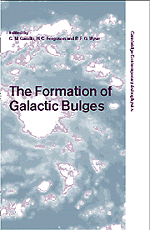Book contents
- Frontmatter
- Contents
- Preface
- Dedication: In Memory of Olin Eggen
- Part 1 Introduction
- Part 2 The Epoch of Bulge Formation
- Part 3 The Timescales of Bulge Formation
- Part 4 Physical Processes in Bulge Formation
- The Role of Bars for Secular Bulge Formation
- Bars and Boxy/Peanut-Shaped Bulges: An Observational Point of View
- Boxy- and Peanut-Shaped Bulges
- A New Class of Bulges
- The Role of Secondary Bars in Bulge Formation
- Radial Transport of Molecular Gas to the Nuclei of Spiral Galaxies
- Dynamical Evolution of Bulge Shapes
- Two-Component Stellar Systems: Phase-Space Constraints
- Central NGC 2146 – A Firehose-Type Bending Instability?
- Bulge Formation: The Role of the Multi-Phase ISM
- Global Evolution of a Self-Gravitating Multi-Phase ISM in the Central Kpc Region of Galaxies
- Part 5 Bulge Phenomenology
- Part 6 Conference Summary
- Index
Bulge Formation: The Role of the Multi-Phase ISM
from Part 4 - Physical Processes in Bulge Formation
Published online by Cambridge University Press: 10 November 2010
- Frontmatter
- Contents
- Preface
- Dedication: In Memory of Olin Eggen
- Part 1 Introduction
- Part 2 The Epoch of Bulge Formation
- Part 3 The Timescales of Bulge Formation
- Part 4 Physical Processes in Bulge Formation
- The Role of Bars for Secular Bulge Formation
- Bars and Boxy/Peanut-Shaped Bulges: An Observational Point of View
- Boxy- and Peanut-Shaped Bulges
- A New Class of Bulges
- The Role of Secondary Bars in Bulge Formation
- Radial Transport of Molecular Gas to the Nuclei of Spiral Galaxies
- Dynamical Evolution of Bulge Shapes
- Two-Component Stellar Systems: Phase-Space Constraints
- Central NGC 2146 – A Firehose-Type Bending Instability?
- Bulge Formation: The Role of the Multi-Phase ISM
- Global Evolution of a Self-Gravitating Multi-Phase ISM in the Central Kpc Region of Galaxies
- Part 5 Bulge Phenomenology
- Part 6 Conference Summary
- Index
Summary
Star formation in bulges has likely been a rather efficient process. An efficient formation of stars depends strongly on the presence of metallic atoms and molecules. These species provide the necessary cooling for the ambient medium to sustain star formation. In order to assess the epoch and timescales for bulge-formation, it is therefore important to investigate the structure of the multi-phase ISM as a function of redshift and the formation of stars in such a medium. Calculations are presented which incorporate feedback effects and the thermal and chemical balance of interstellar gas. Predictions are made for the star formation histories of spheroids of various masses, and compared to similar estimates for disks.
Introduction
Star formation (SF) is a local phenomenon which must find its explanation in the stability and fragmentation of dense molecular clouds. Studies in our own Galaxy have focussed on the structure of dense proto-stellar cores and the chemical and thermal balance of star-forming regions. These studies lend indirect support to a Schmidt (1959) law, but emphasize the need to include explicitly the structure of the multi-phase ISM to model accurately the most important heating and cooling processes. A large unknown in these investigations is the role of feedback. Supernova explosions and stellar radiation associated with the process of SF influence the global physical structure of the interstellar gas which supports this process.
- Type
- Chapter
- Information
- The Formation of Galactic Bulges , pp. 148 - 151Publisher: Cambridge University PressPrint publication year: 2000



